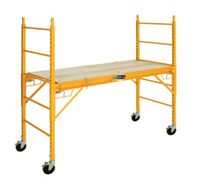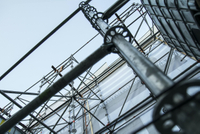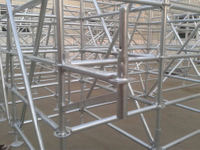Content Menu
● Understanding Scaffolding Systems
● Key Factors to Consider When Choosing a Scaffolding System
>> 1. Nature of the Project
>> 2. Height Requirements
>> 3. Load Capacity
>> 4. Working Conditions
>> 5. Safety Considerations
>> 6. Ease of Assembly and Flexibility
>> 7. Budget Constraints
● Types of Scaffolding Systems
● Detailed Overview of Common Scaffolding Types
>> 1. Frame Scaffolding
>> 2. Tube and Clamp Scaffolding
>> 3. Ringlock Scaffolding
>> 4. Cuplock Scaffolding
>> 5. Suspended Scaffolding
● Conclusion
● FAQ
>> 1. What is a scaffolding system?
>> 2. How do I determine the load capacity needed for my scaffold?
>> 3. What safety standards should I consider when choosing a scaffold?
>> 4. Can I use scaffolding indoors?
>> 5. How do I know which type of scaffold is best for my project?
● Citations:
Choosing the right scaffolding system is crucial for the safety and efficiency of any construction or maintenance project. With various types of scaffolding available, each suited to different tasks and environments, selecting the appropriate system requires careful consideration of several factors. This article will guide you through the essential aspects to consider when choosing a scaffolding system, ensuring that your decision enhances productivity while upholding safety standards.
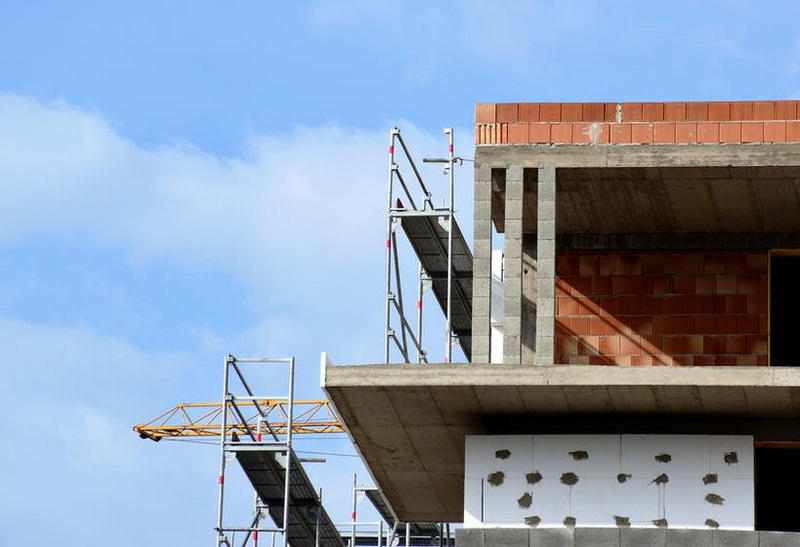
Understanding Scaffolding Systems
Scaffolding systems are temporary structures that support workers and materials during construction, repair, or maintenance activities. They provide a safe working platform at heights, allowing for efficient access to various parts of a structure.
The main types of scaffolding systems include:
- Supported Scaffolding: This type consists of one or more platforms supported by rigid supports like poles or frames. It is commonly used in general construction projects.
- Suspended Scaffolding: These systems involve platforms that hang from an overhead structure, ideal for work on tall buildings.
- Mechanical Scaffolding: Platforms that can be raised or lowered using mechanical devices such as aerial lifts or scissor lifts fall under this category.
Understanding these basic types helps in determining which scaffolding system is best suited for your project.
Key Factors to Consider When Choosing a Scaffolding System
1. Nature of the Project
The type of project is one of the most critical factors in choosing a scaffolding system. Consider the following aspects:
- Project Scope: Assess the scale and complexity of your project, including height, size, and architectural features.
- Type of Work: Different tasks require different scaffolding systems. For instance, heavy-duty construction work may necessitate robust systems like frame scaffolding, while lighter residential work might benefit from simpler setups like rolling scaffolding.
2. Height Requirements
The height at which work will be performed significantly influences the choice of scaffolding:
- Low-rise Projects: For work below 20 feet, basic frame or mobile scaffolds may suffice.
- Medium-height Projects (20–50 feet): A tower scaffold is often required for stability and versatility.
- High-rise Projects (50+ feet): Specialized scaffolds such as mast climbing or suspended systems are necessary for skyscrapers or tall industrial structures.
3. Load Capacity
Understanding the load capacity is essential for safety:
- Light-duty Scaffolding: Suitable for tasks involving minimal weight, such as painting.
- Medium-duty Scaffolding: Appropriate for jobs requiring moderate weight support like masonry work.
- Heavy-duty Scaffolding: Required for large-scale projects needing to support significant weights from multiple workers and equipment.
Always calculate the total weight of workers, tools, and materials to ensure the scaffold can safely handle the load.
4. Working Conditions
The environment where you will be working plays a crucial role in scaffold selection:
- Outdoor vs. Indoor: Outdoor scaffolds must withstand weather conditions. Galvanized steel is often recommended for its resistance to corrosion.
- Ground Stability: For uneven surfaces, adjustable base plates are necessary to provide stability.
- Space Constraints: In confined areas, compact or modular scaffolds may be required to navigate tight spaces safely.
5. Safety Considerations
Safety should always be the top priority when selecting a scaffolding system:
- Ensure compliance with local safety regulations and standards (e.g., OSHA guidelines).
- Inspect all equipment before use and ensure it is sourced from reputable suppliers.
- Provide training for all workers on proper use and safety protocols related to scaffolding.
6. Ease of Assembly and Flexibility
Consider how quickly and easily a scaffolding system can be assembled and disassembled:
- Some systems are designed for quick setup, which can save time and labor costs.
- Modular scaffolds offer flexibility to adapt to varying heights and configurations as needed throughout the project.
7. Budget Constraints
Budget considerations are paramount when selecting a scaffolding system:
- Compare costs across different options while ensuring that safety standards are not compromised.
- Evaluate long-term value versus initial costs; sometimes investing in higher-quality systems can yield savings in time and labor over time.
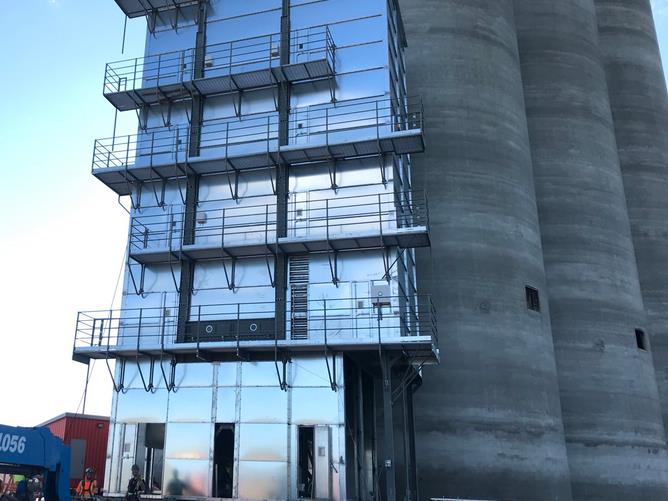
Types of Scaffolding Systems
Here are some commonly used types of scaffolding systems:
| Type | Description |
| Ringlock | A modular system allowing eight-direction connections; versatile and safe. |
| Cuplock | Known for its heavy load-bearing capacity; easy to erect without nuts or bolts. |
| Kwikstage | Offers high adaptability; suitable for various construction needs due to its modular design. |
| Tube and Fitting | Comprising individual tubes connected with fittings; highly flexible for complex structures. |
| Frame Scaffolding | The most common type; consists of vertical frames with horizontal braces providing stability. |
Detailed Overview of Common Scaffolding Types
1. Frame Scaffolding
Frame scaffolding is one of the most widely used types due to its simplicity and effectiveness. It consists of pre-fabricated frames that are connected together to form a stable structure.
Advantages:
- Quick assembly and disassembly.
- Provides ample workspace.
Disadvantages:
- Limited adaptability to complex structures compared to other types like tube and clamp systems.
2. Tube and Clamp Scaffolding
This type uses individual tubes connected by clamps, allowing great flexibility in design and configuration.
Advantages:
- Highly adaptable to irregular shapes.
- High load-bearing capacity.
Disadvantages:
- More time-consuming to set up compared to frame scaffolds.
3. Ringlock Scaffolding
A modular system that allows connections in multiple directions, making it highly versatile for various applications.
Advantages:
- Strong structural integrity.
- Quick assembly due to fewer components.
Disadvantages:
- Requires trained personnel for proper assembly to ensure safety.
4. Cuplock Scaffolding
This type features cups welded onto vertical posts which allow horizontal members to be inserted easily at any height.
Advantages:
- Fast assembly with minimal components.
Disadvantages:
- Limited adaptability compared to tube and clamp systems.
5. Suspended Scaffolding
Ideal for high-rise buildings where workers need access from above rather than below.
Advantages:
- Excellent access for maintenance work on tall structures.
Disadvantages:
- Requires careful rigging and safety measures due to its hanging nature.
Conclusion
Selecting the right scaffolding system is vital for ensuring worker safety, efficiency, and project success. By considering factors such as project type, height requirements, load capacity, working conditions, safety regulations, ease of assembly, flexibility, and budget constraints, you can make an informed choice that meets your specific needs. Always consult with a professional or supplier to ensure you're using the best system tailored to your project requirements.

FAQ
1. What is a scaffolding system?
A scaffolding system is a temporary structure used to support workers and materials during construction or maintenance activities at heights.
2. How do I determine the load capacity needed for my scaffold?
Calculate the total weight of all workers, tools, and materials that will be on the scaffold to ensure it can safely support that load without compromising safety.
3. What safety standards should I consider when choosing a scaffold?
Ensure that your chosen scaffolding complies with local safety regulations such as OSHA guidelines regarding stability, load capacity, guardrails, and access points.
4. Can I use scaffolding indoors?
Yes, but you should consider factors like space constraints and whether additional safety measures are needed based on indoor conditions (e.g., ceiling height).
5. How do I know which type of scaffold is best for my project?
Assess your project's specific requirements including height, load capacity needs, working conditions, and budget constraints before consulting with a professional for tailored recommendations.
Citations:
[1] https://australianscaffolds.com.au/5-steps-to-pick-the-best-scaffolding-for-your-project/
[2] https://www.wm-scaffold.com/scaffolding-system/
[3] https://www.leicesterscaffolding.co.uk/how-to-choose-the-right-scaffolding-system
[4] https://www.adtoscaffold.com/new/pros_and_cons_of_tube_and_clamp_scaffolding.html
[5] https://bdcscaffolding.co.uk/how-to-choose-the-right-scaffolding-system/
[6] https://www.indeed.com/career-advice/career-development/types-of-scaffolding
[7] https://www.hseblog.com/choose-right-type-scaffolding/
[8] https://stakscaffold.co.uk/advantages-and-disadvantages-of-scaffolding-in-construction/
[9] https://scaffoldingrentalandsales.com/blog/choosing-the-right-scaffolding-for-your-project-a-comprehensive-guide/
[10] https://scaffoldconstructi.wixsite.com/framescafffoldexpert/post/frame-scaffolding-vs-other-scaffolding-systems-pros-and-cons
[11] https://ncmt.ae/how-to-choose-the-right-scaffolding-system-for-your-activity/













